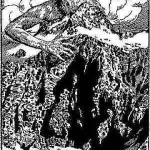Created by: Mojca Benkovich
Number of Blossarys: 6
Vesna is the goddess of spring and nature. In many Slavic languages today (Russian, Slovak, Czech, Slovene), the word "vesna" means "spring". One of the most favourite deities, Vesna was worshipped because she would bring life after death - after winter she would bring warmth, green fields, pleasant weather, flowers, joy into nature. Her biggest enemy was Morana, the ruler of winter and death. They would always fight in the wintertime, and Vesna would win in spring. However, their struggle was cyclical and never final - which brought the four seasons. Vesna was never alone - she was accompanied by Gerovit, who always watched over her, and Stribog, the god of wind and air. She is represented as a young girl in a white gown and with flowers in her hair, with big eyes and always filled with joy and always smiling.
Boginja pomladi, glasnica boginje Nore. Njeno ime v tem pomenu ni ohranjeno, srečamo pa ga v bajki o Kersniku. Mnogo bolj živa je postava boginje Vesne pri drugih slovanskih narodih, zlasti pri Rusih in Ukrajincih. Ta boginja je bila vseslovanska, izvirno venetska. Nekaj sledov kaže na njeno pristnost tudi med božanstvi Karantancev.
Živa, also Żiwia, Siva, Sieba or Razivia, was the Slavic goddess of love and fertility. Her name means "living, being, existing". Sieba's consort was Siebog, her male equivalent. She is the protector of children and also called Zizileja. It was believed that she was pregnant during the summer so it was forbidden to hurt the ground during the summer.
Boginja življenja, rodovitnosti, ljubezni. Simbolično je poosebljena v studencu sveže vode, viru vsega življenja. Odraža žensko postavo, mladost, lepoto, milino, predvsem pa življenje in njegovo nastajanje. Njeno ime se verjetno nanaša na živo vodo.
God of war. from the name derives the name Odin Vodin – the Supreme God in Scandinavian and old germanskem the pantheon. The name is derived from "lead" literally (in the war). Odin is the origin and meaning of the then venetski of God. when they are missionaries, they were virtually wiped out Paganism hotels character is often in the devil is a distortion of Vodina, but many properties are in the Vodinove tales of the mythical heroes of
Bog vojne. Iz imena Vodin izhaja tudi ime Odin – vrhovni bog v skandinavskem in tudi starem germanskem panteonu. Ime dobesedno izhaja iz "voditi" (v vojni). Odin je torej po svojem izvoru in pomenu venetski bog. Ko so misijonarji hoteli iztrebili poganstvo, so lik Vodina pogosto popačili v hudiča, vendar so mnoge Vodinove lastnosti prešle tudi v zgodbe o bajeslovnih slovenskih junakih
Svetovid is the Slavic deity of war, fertility and abundance. He is often considered a local Rugian variant of the pan-Slavic god Perun. Sometimes referred to as Beli (or Byali) Vid (Beli = white, bright, shining), Svetovid is often depicted with a sword or bow in one hand and a drinking horn in the other. Other important symbols included the white horse, which were kept in his temple and used in divination. Svetovid is associated with war and divination and depicted as a four-headed god with two heads looking forward and two back. A statue portraying the god shows him with four heads, each one looking in a separate direction, a symbolical representation of the four directions of the compass, and also perhaps the four seasons of the year. Each face had a specific colour. The northern face of this totem was white (hence White Russia / Belarus and the White Sea), the western, red (hence Red Ruthenia), the southern, black (hence the Black Sea) and the eastern, green (hence Zelenyj klyn).
Svetovid je veljal je za stvarnika sveta in življenja. Značilnosti: 1. štirje obrazi- videl je na vse strani, ves svet in ga branil pred silami zla; 2. meč - gospodar pravice; 3. lok - bil je bog ljubezni; 4. rog - bil je bog dobre letine; 5. beli konj, beli kragulj, lipa, petelin …
Triglav, also sometimes called troglav, is a god or a complex of gods in Slavic mythology, similar in nature to the Trinity in Christianity or Trimurti in Hinduism. Often, he is considered to be the same deity as Troyan. Triglav is a unity of three gods. The exact members of the triad vary by place and time. An early variation included Svarog, Perun, and Dažbog/Dajbog. Later, Dažbog was replaced by Svetovid or Veles. Triglav is usually described as a fusion of these gods. More rarely he is said to be their son. It may also be a unity of lesser gods (Lesser Triglav).
Triglav je veljal je za večnega očeta in poleg osi sveta predstavlja trojno razsežnost (nebo, zemlja, podzemlje). Značilnosti: 1. kamnita glava s tremi obrazi- tri glave; 2. črni orel, simbol vrhovnih božanstev. Ponazarja nebo in vesolje. Črna barva je simbol minljivosti, večnosti; 3. črni konj, mu je bil posvečen in je služil za prerokovanje.


 English (EN)
English (EN)